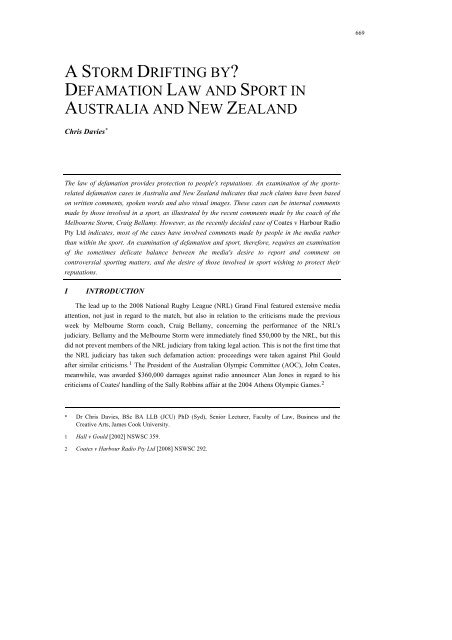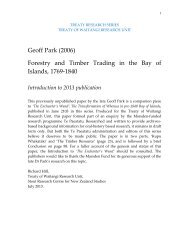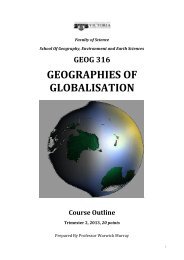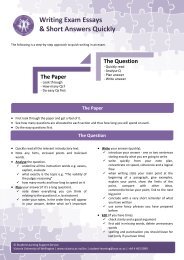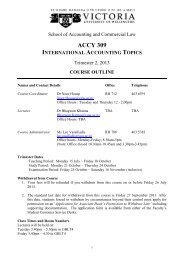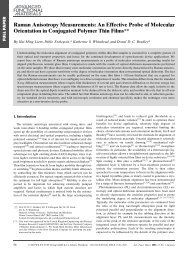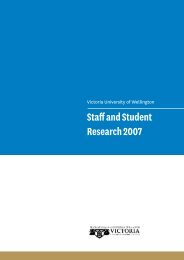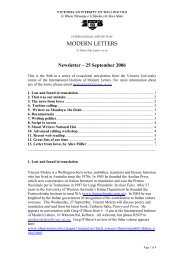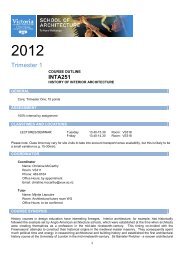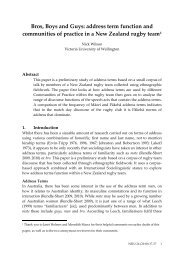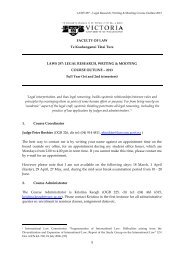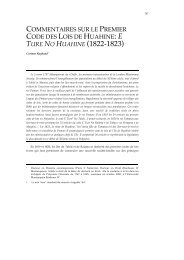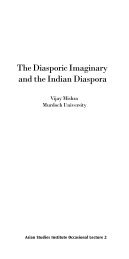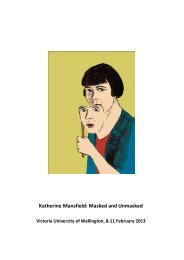defamation law and sport in australia and new zealand - Victoria ...
defamation law and sport in australia and new zealand - Victoria ...
defamation law and sport in australia and new zealand - Victoria ...
You also want an ePaper? Increase the reach of your titles
YUMPU automatically turns print PDFs into web optimized ePapers that Google loves.
669<br />
A STORM DRIFTING BY?<br />
DEFAMATION LAW AND SPORT IN<br />
AUSTRALIA AND NEW ZEALAND<br />
Chris Davies *<br />
The <strong>law</strong> of <strong>defamation</strong> provides protection to people's reputations. An exam<strong>in</strong>ation of the <strong>sport</strong>srelated<br />
<strong>defamation</strong> cases <strong>in</strong> Australia <strong>and</strong> New Zeal<strong>and</strong> <strong>in</strong>dicates that such claims have been based<br />
on written comments, spoken words <strong>and</strong> also visual images. These cases can be <strong>in</strong>ternal comments<br />
made by those <strong>in</strong>volved <strong>in</strong> a <strong>sport</strong>, as illustrated by the recent comments made by the coach of the<br />
Melbourne Storm, Craig Bellamy. However, as the recently decided case of Coates v Harbour Radio<br />
Pty Ltd <strong>in</strong>dicates, most of the cases have <strong>in</strong>volved comments made by people <strong>in</strong> the media rather<br />
than with<strong>in</strong> the <strong>sport</strong>. An exam<strong>in</strong>ation of <strong>defamation</strong> <strong>and</strong> <strong>sport</strong>, therefore, requires an exam<strong>in</strong>ation<br />
of the sometimes delicate balance between the media's desire to report <strong>and</strong> comment on<br />
controversial <strong>sport</strong><strong>in</strong>g matters, <strong>and</strong> the desire of those <strong>in</strong>volved <strong>in</strong> <strong>sport</strong> wish<strong>in</strong>g to protect their<br />
reputations.<br />
I<br />
INTRODUCTION<br />
The lead up to the 2008 National Rugby League (NRL) Gr<strong>and</strong> F<strong>in</strong>al featured extensive media<br />
attention, not just <strong>in</strong> regard to the match, but also <strong>in</strong> relation to the criticisms made the previous<br />
week by Melbourne Storm coach, Craig Bellamy, concern<strong>in</strong>g the performance of the NRL's<br />
judiciary. Bellamy <strong>and</strong> the Melbourne Storm were immediately f<strong>in</strong>ed $50,000 by the NRL, but this<br />
did not prevent members of the NRL judiciary from tak<strong>in</strong>g legal action. This is not the first time that<br />
the NRL judiciary has taken such <strong>defamation</strong> action: proceed<strong>in</strong>gs were taken aga<strong>in</strong>st Phil Gould<br />
after similar criticisms. 1 The President of the Australian Olympic Committee (AOC), John Coates,<br />
meanwhile, was awarded $360,000 damages aga<strong>in</strong>st radio announcer Alan Jones <strong>in</strong> regard to his<br />
criticisms of Coates' h<strong>and</strong>l<strong>in</strong>g of the Sally Robb<strong>in</strong>s affair at the 2004 Athens Olympic Games. 2<br />
* Dr Chris Davies, BSc BA LLB (JCU) PhD (Syd), Senior Lecturer, Faculty of Law, Bus<strong>in</strong>ess <strong>and</strong> the<br />
Creative Arts, James Cook University.<br />
1 Hall v Gould [2002] NSWSC 359.<br />
2 Coates v Harbour Radio Pty Ltd [2008] NSWSC 292.
670 (2009) 40 VUWLR<br />
Such comments, however, are examples of the almost daily criticisms made by the media <strong>in</strong><br />
relation to <strong>sport</strong>. This then raises the question as to when do such comments constitute valid<br />
criticism, <strong>and</strong> when do they constitute <strong>defamation</strong>? Visual images relat<strong>in</strong>g to <strong>sport</strong> are also<br />
published on a daily basis, either as part of <strong>new</strong>s items on television, <strong>in</strong> papers or magaz<strong>in</strong>es, or as<br />
advertisements. Aga<strong>in</strong> this raises the question as to the circumstances under which such images<br />
become defamatory. S<strong>in</strong>ce New Zeal<strong>and</strong> is now <strong>in</strong>volved <strong>in</strong> trans-Tasman competitions with<br />
Australian teams <strong>in</strong> rugby league, rugby union, soccer, netball <strong>and</strong> basketball, it is also worth tak<strong>in</strong>g<br />
<strong>in</strong>to consideration the <strong>law</strong> of <strong>defamation</strong> <strong>in</strong> both Australia <strong>and</strong> New Zeal<strong>and</strong> when exam<strong>in</strong><strong>in</strong>g the<br />
question of <strong>defamation</strong> <strong>and</strong> <strong>sport</strong>.<br />
This paper will therefore exam<strong>in</strong>e the <strong>law</strong> of <strong>defamation</strong> <strong>in</strong> regard to <strong>sport</strong> <strong>in</strong> Australia 3 <strong>and</strong><br />
New Zeal<strong>and</strong> 4 by exam<strong>in</strong><strong>in</strong>g the <strong>in</strong>cidents <strong>in</strong>volv<strong>in</strong>g the comments made by Bellamy, Gould <strong>and</strong><br />
Jones as well as other known <strong>sport</strong> cases <strong>in</strong> Australia <strong>and</strong> New Zeal<strong>and</strong> <strong>in</strong>volv<strong>in</strong>g the pr<strong>in</strong>t medium,<br />
spoken comments <strong>and</strong> visual images. What will also be discussed is the often delicate balance<br />
between the media's need to discuss controversial <strong>in</strong>cidents <strong>in</strong> <strong>sport</strong>, <strong>and</strong> the <strong>law</strong>'s need to protect<br />
people's reputation.<br />
II<br />
SPORT, DEFAMATION AND THE SPOKEN WORD<br />
A The Bellamy Case<br />
The <strong>in</strong>cident <strong>in</strong>volv<strong>in</strong>g Bellamy <strong>and</strong> Melbourne Storm arose after its capta<strong>in</strong>, Cameron Smith,<br />
was suspended for two matches week for an illegal 'grapple' tackle <strong>in</strong> which a player deliberately<br />
puts his arm around the tackled player's throat. The result of this suspension was that Smith missed<br />
both the Prelim<strong>in</strong>ary F<strong>in</strong>al <strong>and</strong> the Gr<strong>and</strong> F<strong>in</strong>al. Dur<strong>in</strong>g a press conference after the Storm's w<strong>in</strong> <strong>in</strong><br />
the Prelim<strong>in</strong>ary F<strong>in</strong>al, <strong>and</strong> with Brian Waldron, the club's chief executive, beside him, Bellamy<br />
launched <strong>in</strong>to an attack on the judiciary's decision to suspend Smith. His claims were that the<br />
3 Note that uniform <strong>defamation</strong> Acts were adopted by the various Australian jurisdictions <strong>in</strong> 2006. In those<br />
states that had an earlier <strong>defamation</strong> Act, rather than actually repeal<strong>in</strong>g these earlier pieces of legislation,<br />
each <strong>new</strong> Act simply states that the general <strong>law</strong> <strong>in</strong> regard to <strong>defamation</strong> applies "as if those statutes has<br />
never been enacted". The relevant legislation <strong>in</strong> each state <strong>and</strong> territory <strong>in</strong> regard to <strong>defamation</strong> are now the<br />
Civil Law (Wrongs) Act 2002 (ACT); Defamation Act 2006 (NT); Defamation Act 2005 (NSW);<br />
Defamation Act 2005 (Qld); Defamation Act 2005 (SA); Defamation Act 2005 (Tas); Defamation Act 2005<br />
(Vic); Defamation Act 2005 (WA). For further discussion see David Rolph "Uniform at Last? An Overview<br />
of Uniform, National Defamation Law" (2006) 76 Precedent 35.<br />
4 Until 1954, <strong>defamation</strong> <strong>law</strong> <strong>in</strong> New Zeal<strong>and</strong> was covered by the Libel Act 1792 (UK), the Law of Libel<br />
Amendment Act 1910 <strong>and</strong> the Law of Libel Amendment Act 1933. These three Acts were then expressly<br />
repealed by s 23 of the Defamation Act 1954. There were two subsequent amendments to the 1954 Act, the<br />
Defamation Amendment Act 1958 <strong>and</strong> the Defamation Amendment Act 1974 before the enactment of the<br />
Defamation Act 1992, schedule 3 of which repealed these 1954-74 Acts.
A STORM DRIFTING BY? DEFAMATION LAW AND SPORT IN AUSTRALIA AND NEW ZEALAND 671<br />
judiciary had succumbed to the media hype surround<strong>in</strong>g the <strong>in</strong>cident, <strong>and</strong> that the bookmakers had<br />
known of the result of the hear<strong>in</strong>g before it had even been held. 5<br />
This verbal attack led to the NRL f<strong>in</strong><strong>in</strong>g the club $50,000 for attack<strong>in</strong>g the judiciary's <strong>in</strong>tegrity,<br />
but this was not enough for the members of the judiciary panel, Darrell Williams, Royce Ayliffe <strong>and</strong><br />
Darren Britt, who also called for an apology from Bellamy <strong>and</strong> the Melbourne Storm. The Panel<br />
also <strong>in</strong>dicated legal action would commence if an apology was not forthcom<strong>in</strong>g by the time of the<br />
NRL Gr<strong>and</strong> F<strong>in</strong>al. Bellamy refused to make an apology <strong>in</strong> the lead up to the Gr<strong>and</strong> F<strong>in</strong>al, 6 though<br />
he <strong>and</strong> Waldron made a belated apology <strong>in</strong> the days follow<strong>in</strong>g the match. Bellamy stated that he had<br />
not <strong>in</strong>tended "to question the <strong>in</strong>tegrity or reputation of the members of the judiciary." 7 Despite the<br />
apology, members of the judiciary panel have commenced legal action <strong>in</strong> the NSW Supreme<br />
Court. 8 On the first day of proceed<strong>in</strong>gs Bellamy <strong>and</strong> Waldron repeated the apology but this was not<br />
accepted by the members of the judiciary panel <strong>and</strong> they are cont<strong>in</strong>u<strong>in</strong>g with the action. 9<br />
The <strong>in</strong>cident clearly <strong>in</strong>dicates a judiciary body, such as the NRL's, will draw a l<strong>in</strong>e at what it<br />
will accept as fair criticism of its decisions. However, it also illustrates that an immediate <strong>and</strong><br />
genu<strong>in</strong>e apology would have satisfied the panel. This perhaps reflects that, as former first grade<br />
players, they all understood the culture of <strong>sport</strong> <strong>and</strong> that the passion it can generate can lead to<br />
comments be<strong>in</strong>g made <strong>in</strong> the heat of the moment which are later regretted by the makers. The case<br />
<strong>in</strong>volv<strong>in</strong>g Bellamy, however, is not the first time that NRL judiciary have taken legal proceed<strong>in</strong>gs as<br />
comments made by Phil Gould, a well known former rugby league player <strong>and</strong> coach now <strong>in</strong>volved<br />
<strong>in</strong> the media, were also the subject of court action.<br />
B Hall v Gould<br />
Spoken criticisms were made by Gould dur<strong>in</strong>g the 2GB radio broadcast which aired on 16<br />
August, 2001. The imputations pleaded <strong>in</strong> regard to the 2GB broadcast were that the Panel had acted<br />
perversely <strong>in</strong> f<strong>in</strong>d<strong>in</strong>g Smith guilty <strong>in</strong> strik<strong>in</strong>g another player; that they had acted corruptly <strong>in</strong> f<strong>in</strong>d<strong>in</strong>g<br />
Smith guilty; <strong>and</strong> that the Panel acted so unfairly that other players cannot expect to get a fair<br />
5 S Honeysett <strong>and</strong> M Pelly "Bellamy's Sorry State of Affairs" (8 October 2008) The Australian 22.<br />
6 S Honeysett <strong>and</strong> D Koch "Bellamy a Step Closer to Litigation" (2 October 2008) The Australian 18.<br />
7 Honeysett <strong>and</strong> Pelly, above n 5, 22.<br />
8 A Webster "NRL punts judiciary" (6 March 2009) The Daily Telegraph Sydney. Note that the NRL then<br />
suspended the three judicial members replac<strong>in</strong>g them with Paul Conlon, Brad Clyde <strong>and</strong> Sean Garlick. It<br />
should be further noted that one of the changes made to the uniform <strong>defamation</strong> Acts was the <strong>in</strong>troduction<br />
of clear guidel<strong>in</strong>es as to which jurisdiction the matter should be heard <strong>in</strong>. If the publication has been <strong>in</strong> a<br />
more than one jurisdiction it is <strong>in</strong> the jurisdiction <strong>in</strong> which the harm caused by the publication has its closest<br />
connection, with one consideration be<strong>in</strong>g where the pla<strong>in</strong>tiffs reside which <strong>in</strong> this case was New South<br />
Wales: see Defamation Act 2005, s 11 (NSW).<br />
9 A Proszenko "Apology by Storm Pair Cuts no Ice with Judiciary Trio" (3 May 2009) The Sun-Herald<br />
Sydney, 91.
672 (2009) 40 VUWLR<br />
hear<strong>in</strong>g. 10 In relation to the use of the word perversely, Lev<strong>in</strong>e J stated that "the context can be<br />
referred to <strong>in</strong> order to re<strong>in</strong>force the available lay mean<strong>in</strong>g of an ord<strong>in</strong>ary English word". 11 In regard<br />
to capacity, his Honour stated that as a matter of <strong>law</strong> the statement was capable of carry<strong>in</strong>g this<br />
mean<strong>in</strong>g, <strong>and</strong> that the tenor of the broadcast was such that it easily led itself to the availability of<br />
such a mean<strong>in</strong>g. 12 It was therefore capable of be<strong>in</strong>g defamatory. 13<br />
The second imputation <strong>in</strong>volv<strong>in</strong>g the use of the word "corruptly" <strong>and</strong> asserted that Ayliffe,<br />
Roberts <strong>and</strong> Williams "did not br<strong>in</strong>g their own m<strong>in</strong>ds to bear on the matter, but blithely accepted the<br />
mere op<strong>in</strong>ion of the Commissioner". 14 This matter compla<strong>in</strong>ed off was capable of carry<strong>in</strong>g this<br />
imputation <strong>and</strong> was capable of be<strong>in</strong>g defamatory. 15 The third imputation from the radio broadcast<br />
was challenged on the basis of capacity <strong>in</strong> the sense that a published matter referr<strong>in</strong>g "to misconduct<br />
on one occasion is <strong>in</strong>capable of mak<strong>in</strong>g a general charge of the same misconduct", with Lev<strong>in</strong>e J<br />
stat<strong>in</strong>g that this imputation was framed as a general charge. 16 His Honour then held that the clos<strong>in</strong>g<br />
remarks where Gould had stated he had "been very critical of the Judiciary over the last 18<br />
months", 17 supported the availability of this imputation. This was held to be capable of be<strong>in</strong>g<br />
carried, <strong>and</strong> capable of be<strong>in</strong>g defamatory. 18<br />
Although the matter was settled out of court without the matter go<strong>in</strong>g to a jury, 19 Justice<br />
Lev<strong>in</strong>e's decision <strong>in</strong>dicates that comments made on the radio by someone work<strong>in</strong>g <strong>in</strong> the media<br />
about those carry<strong>in</strong>g out official duties with<strong>in</strong> a <strong>sport</strong> can be capable of be<strong>in</strong>g defamatory. It is also<br />
suggested that <strong>in</strong> the Bellamy case a similar conclusion may well be reached as the comments could<br />
be considered to lower the reputation of the members of the judiciary. Comments made on a radio<br />
programme concern<strong>in</strong>g the performance of an official were also the issue <strong>in</strong> Coates v Harbour<br />
Radio Pty Ltd.<br />
10 Hall & Ors v Gould, above n 1, 359.<br />
11 Ibid, para 9.<br />
12 Ibid, para 11.<br />
13 Ibid, para 12.<br />
14 Ibid, para 13.<br />
15 Ibid, para 15.<br />
16 Ibid.<br />
17 Ibid, para 17.<br />
18 Ibid, para 18.<br />
19 Honeysett <strong>and</strong> Koch, above n 6, 18.
A STORM DRIFTING BY? DEFAMATION LAW AND SPORT IN AUSTRALIA AND NEW ZEALAND 673<br />
C Coates v Harbour Radio Pty Ltd<br />
1 Background<br />
Sally Robb<strong>in</strong>s was selected for the Australian Women's Eights that made the f<strong>in</strong>al at 2004<br />
Athens Olympics, 20 but about half way through the race Sally Robb<strong>in</strong>s stopped row<strong>in</strong>g <strong>and</strong> lay<br />
down <strong>in</strong> the boat. When the team returned to the official f<strong>in</strong>ish area comments were then made <strong>in</strong><br />
the presence of the media, <strong>in</strong>clud<strong>in</strong>g one likely to have been made by one of the crew which was<br />
"Tell the truth, Sally." 21<br />
Coates had watched the race on television <strong>and</strong> had seen Robb<strong>in</strong>s collapse <strong>in</strong> the boat, <strong>and</strong> a short<br />
time later had answered questions with the media. A question was put to him by a reporter that it<br />
was "un-Australian" to criticise your team mates <strong>and</strong> Coates had replied, "Yes, it is un-Australian to<br />
bag your mates". 22 This was later broadcasted on Channel Seven. 23 One of the other members of<br />
the crew, Kyeema Doyle, later gave an <strong>in</strong>terview with the Australian Broadcast<strong>in</strong>g Commission<br />
(ABC) on the morn<strong>in</strong>g of 23 August <strong>in</strong> which she defended the criticisms made by the crew <strong>in</strong> the<br />
aftermath of the race. This was <strong>in</strong> breach of the Olympic team rules regard<strong>in</strong>g talk<strong>in</strong>g to the media,<br />
<strong>and</strong> as a consequence Coates told Peter Huggett, the Assistant Team Manager for row<strong>in</strong>g, to tell the<br />
team to rema<strong>in</strong> <strong>in</strong> the Olympic village. 24<br />
One of the members of the crew, Karen Foulkes, then decided that the team needed help <strong>and</strong> left<br />
a message on Coates' phone to that effect, though he did not respond as he was busy at the time <strong>and</strong><br />
also because he k<strong>new</strong> that a team meet<strong>in</strong>g had been scheduled for 7.30am the follow<strong>in</strong>g day. 25<br />
Another crew member <strong>and</strong> the capta<strong>in</strong> of the women's row<strong>in</strong>g team, Vicki Roberts, contacted one of<br />
the athlete liaison officers, John Eales, a former Australian rugby union capta<strong>in</strong>. Eales agreed to<br />
have a meet<strong>in</strong>g at 10.00pm that even<strong>in</strong>g <strong>and</strong> also rang Coates to <strong>in</strong>form him of this. 26 At the<br />
meet<strong>in</strong>g with Roberts, Foulkes <strong>and</strong> Wilson, the crew members <strong>in</strong>dicated they wished to move<br />
forward from the situation, with Eales suggest<strong>in</strong>g that he would speak to Robb<strong>in</strong>s. They agreed, <strong>and</strong><br />
Eales then spoke to Robb<strong>in</strong>s who acknowledged that the other three women wanted an explanation<br />
20 Coates v Harbour Radio Pty Ltd, above n 2, 292.<br />
21 Ibid, para 22.<br />
22 Ibid, para 43.<br />
23 Ibid, para 45.<br />
24 Ibid, para 51.<br />
25 Ibid, para 61.<br />
26 Ibid, para 64.
674 (2009) 40 VUWLR<br />
of what had happened. 27 It was agreed that such a meet<strong>in</strong>g needed to be with the whole team <strong>and</strong><br />
that a public statement also needed to be made. 28<br />
The follow<strong>in</strong>g morn<strong>in</strong>g, 24 August, Eales met with the whole team with Robb<strong>in</strong>s giv<strong>in</strong>g the<br />
team an explanation as to what had happened. While several members of the crew expressed their<br />
feel<strong>in</strong>gs about what had happened, Eales stated <strong>in</strong> evidence that he could not recall any criticisms<br />
be<strong>in</strong>g made of Robb<strong>in</strong>s. It was also agreed that Robb<strong>in</strong>s <strong>and</strong> a few other team members needed to<br />
speak to the press. 29 The team then met with Coates, who apologised for his un-Australian<br />
comment, 30 <strong>and</strong> a press conference was arranged for later that day. Robb<strong>in</strong>s acknowledged to the<br />
press that she had had similar problems <strong>in</strong> other races prior to the Olympic Games <strong>and</strong> was see<strong>in</strong>g a<br />
<strong>sport</strong>s psychologist about what appeared to be mental weaknesses that affected her <strong>in</strong> big races. 31<br />
It was these events that lead to the comments at the centre of Coates v Harbour Radio Pty Ltd,<br />
namely those made by Jones dur<strong>in</strong>g his early morn<strong>in</strong>g radio programme some three <strong>and</strong> half months<br />
later. The first occurred at 5.55am on 8 December, 2004, dur<strong>in</strong>g a conversation with Andrew<br />
Moore. Jones stated that the story raised "significant questions … over the leadership of the<br />
Australian Olympic movement" <strong>and</strong> that "they practiced a cover up from the moment someth<strong>in</strong>g<br />
happened to Sally Robb<strong>in</strong>s <strong>and</strong> the leadership of the Olympic movement, Coates <strong>and</strong> others,<br />
virtually were tell<strong>in</strong>g these people what to say." He went on to say that "the leadership here was<br />
sadly lack<strong>in</strong>g <strong>in</strong> how to h<strong>and</strong>le this", <strong>and</strong> that Coates had been <strong>in</strong> charge of too many Olympic<br />
committees <strong>and</strong> it was "time to give someone else a go". 32 Later that morn<strong>in</strong>g at 8.07am Jones made<br />
further comments, claim<strong>in</strong>g that parents of Australia's rowers had accused the <strong>sport</strong><strong>in</strong>g officials of<br />
order<strong>in</strong>g a cover up <strong>and</strong> that the AOC had told the crew what to say at the <strong>new</strong>s conferences. He<br />
further stated that this "has been badly h<strong>and</strong>led" <strong>and</strong> that there were many say<strong>in</strong>g that "it really is<br />
time for John Coates to give the guernsey to someone else." 33 On the follow<strong>in</strong>g morn<strong>in</strong>g, Jones<br />
made further statements that "it was the Olympic leadership that were at fault", that Coates "has<br />
been there too long <strong>and</strong> someth<strong>in</strong>g needs to be done", <strong>and</strong> that the "h<strong>and</strong>l<strong>in</strong>g of the whole bus<strong>in</strong>ess<br />
was awful". 34<br />
27 Ibid, para 65.<br />
28 Ibid, para 66.<br />
29 Ibid, para 72.<br />
30 Ibid, para 78.<br />
31 Ibid, para 79.<br />
32 Ibid, para 1.<br />
33 Ibid, para 2.<br />
34 Ibid, para 3.
A STORM DRIFTING BY? DEFAMATION LAW AND SPORT IN AUSTRALIA AND NEW ZEALAND 675<br />
The imputations that arose from these broadcasts were that Coates had ordered a cover-up, that<br />
his leadership was lack<strong>in</strong>g <strong>and</strong> <strong>in</strong>competent at the relevant time, <strong>and</strong> that he had bullied the crew<br />
<strong>in</strong>to say<strong>in</strong>g what he wanted them to say at the <strong>new</strong>s conferences. 35 The defences of substantial truth,<br />
contextual truth <strong>and</strong> comment were then raised by Harbour Radio Pty Ltd <strong>and</strong> Jones. 36<br />
2 Judgment of Adams J<br />
The first imputation addressed by Adams J was that Coates had practised or ordered a cover up<br />
over Robb<strong>in</strong>s' collapse. 37 His Honour def<strong>in</strong>ed cover up as be<strong>in</strong>g a term used where there is some<br />
duty, either legal or moral, to disclose certa<strong>in</strong> facts <strong>and</strong> there is a refusal to disclose those facts <strong>and</strong><br />
there is an attempt to deflect any enquiry. It therefore <strong>in</strong>volves disguis<strong>in</strong>g as well as conceal<strong>in</strong>g the<br />
truth, though mere silence was not a cover up. 38<br />
The defendants' written <strong>and</strong> oral submissions had argued that <strong>in</strong>formation might be disclosed at<br />
a press conference which could be damag<strong>in</strong>g or embarrass<strong>in</strong>g to those who had been responsible for<br />
the selection of Robb<strong>in</strong>s, namely Row<strong>in</strong>g Australia <strong>and</strong> the Australian Olympic Committee.<br />
However, it was noted by Adams J that Coates had played no part <strong>in</strong> the selection of the rowers for<br />
the 2004 Olympics as this was determ<strong>in</strong>ed by the relevant <strong>sport</strong><strong>in</strong>g organisation, <strong>and</strong> it was not part<br />
of his responsibilities to satisfy himself as to the physical or mental capacity of anyone who was<br />
nom<strong>in</strong>ated for the Olympic team. 39 There was noth<strong>in</strong>g, therefore, <strong>in</strong> the selection criteria to<br />
embarrass Row<strong>in</strong>g Australia, let alone the Australian Olympic Committee <strong>and</strong> its president. Coates<br />
had been made aware of the previous problems with Robb<strong>in</strong>s f<strong>in</strong>ish<strong>in</strong>g races on 23 August, "but this<br />
knowledge was <strong>in</strong>capable of giv<strong>in</strong>g rise even to a frisson of impropriety, let alone a sc<strong>and</strong>al". 40<br />
Adams J then held that "the imputations suggestive of a cover-up were patently false [<strong>and</strong>] they<br />
could not survive even the most cursory exam<strong>in</strong>ation of the team's press conference". 41<br />
The second imputation was that Coates had bullied the crew members <strong>in</strong>to say<strong>in</strong>g what he<br />
wanted them to say after the <strong>in</strong>cident <strong>and</strong> at a <strong>new</strong>s conference. 42 Adams J noted that the "notion of<br />
bully<strong>in</strong>g <strong>in</strong>volves the misuse of a strength or power to coerce or suppress a weaker person". 43 The<br />
35 Ibid, para 4.<br />
36 Ibid, para 5.<br />
37 Ibid, para 94.<br />
38 Ibid.<br />
39 Ibid, para 11.<br />
40 Ibid, para 98.<br />
41 Ibid, para 109.<br />
42 Ibid, para 110.<br />
43 Ibid, para 112.
676 (2009) 40 VUWLR<br />
actual acts allegedly <strong>in</strong>volv<strong>in</strong>g bully<strong>in</strong>g were the requirement that the crew members return to the<br />
village on 23 August, the "un-Australian" comment, <strong>and</strong> a direction at the press conference that no<br />
criticism was to be made of another rower. 44 Adams J, however, held that Coates' conduct did not<br />
amount to bully<strong>in</strong>g as it lacked the element of oppression, <strong>and</strong>, to the contrary, the pla<strong>in</strong>tiff had<br />
acted reasonably <strong>and</strong> appropriately. 45 The requirement that the team return to the village was "a<br />
reasonable <strong>and</strong> sensible response to the develop<strong>in</strong>g problem", 46 <strong>and</strong> as Chef de Mission, he had the<br />
authority to take action that was appropriate for the good of the team. 47 His Honour also held that it<br />
had been the team who had decided what should be said at the press conference, 48 <strong>and</strong> therefore the<br />
suggestion that they were bullied <strong>in</strong>to say<strong>in</strong>g what was said at the conference was completely<br />
untrue. 49 Adams J also held that the "un-Australian" comment did not <strong>in</strong>volve bully<strong>in</strong>g, as Coates<br />
was entitled to condemn any disparagement by one member of the team by another. While his<br />
Honour stated that the choice of strong language was unwise <strong>in</strong> the situation, he po<strong>in</strong>ted out that<br />
Coates had apologised at the earliest opportunity. 50<br />
The third imputation was that Coates' leadership was sadly lack<strong>in</strong>g <strong>and</strong> <strong>in</strong>competent <strong>in</strong> deal<strong>in</strong>g<br />
with the Robb<strong>in</strong>s affair. 51 In decid<strong>in</strong>g on this matter Adams J referred to a report made by head<br />
row<strong>in</strong>g coach, Harold Jahrl<strong>in</strong>g, <strong>and</strong> noted that by the time Robb<strong>in</strong>s' name had come to the AOC, the<br />
issues surround<strong>in</strong>g her competence had already been determ<strong>in</strong>ed by Row<strong>in</strong>g Australia, <strong>and</strong> "it was<br />
not for the Australian Olympic Committee to second guess Row<strong>in</strong>g Australia <strong>in</strong> this respect". 52 The<br />
selection process, therefore, formed no part of Coates' management or leadership of the Australian<br />
Olympic Committee, nor did it demonstrate any <strong>in</strong>competence <strong>in</strong> his deal<strong>in</strong>g with the <strong>in</strong>cident, or<br />
the way he h<strong>and</strong>led the Robb<strong>in</strong>s affair. 53 Any reference to team management was to that of Row<strong>in</strong>g<br />
Australia for which Coates was not responsible. 54<br />
44 Ibid.<br />
45 Ibid, para 113.<br />
46 Ibid, para 114.<br />
47 Ibid, para 116.<br />
48 Ibid, para 118.<br />
49 Ibid, para 119.<br />
50 Ibid, para 121.<br />
51 Ibid, para 123.<br />
52 Ibid, para 126.<br />
53 Ibid, para 130.<br />
54 Ibid.
A STORM DRIFTING BY? DEFAMATION LAW AND SPORT IN AUSTRALIA AND NEW ZEALAND 677<br />
Another fact relied on by Harbour Radio was that Coates did not meet or talk to the crew<br />
members until 24 August. Adams J held, however, that the only opportunity to meet the team was<br />
on the even<strong>in</strong>g of the race, namely the 22 August, but it was obvious that this was not an occasion<br />
when such a consultation was appropriate. As it had not been shown that there was another<br />
appropriate time for a meet<strong>in</strong>g, there was no basis for criticis<strong>in</strong>g Coates' management or leadership<br />
for not meet<strong>in</strong>g with the crew before the morn<strong>in</strong>g of 24 August. 55<br />
The f<strong>in</strong>al matter to deal with was the "un-Australian" comment, with his Honour stat<strong>in</strong>g that the<br />
context of its use was <strong>in</strong> regard to the fact that it was the wrong th<strong>in</strong>g for one team member to<br />
criticise another. Coates had also admitted himself that it was not a remark that he should have made<br />
as a manager <strong>and</strong> a leader. 56 Adams J then held that it was a momentary lapse <strong>and</strong> could not be<br />
seriously regarded as reflect<strong>in</strong>g on Coates' leadership or management when the crisis was<br />
considered as a whole. 57<br />
As Harbour Radio had not established the truth of the imputations, it was then a question as to<br />
whether the imputations amounted to comment relat<strong>in</strong>g to a matter of public <strong>in</strong>terest, a statutory<br />
defence under the relevant act, the Defamation Act 1974 (NSW). Adams J noted that a comment<br />
will only be defensible if it can be clearly identified apart from any matters of fact upon which it<br />
might be based, <strong>and</strong> that these facts must be sufficiently <strong>in</strong>dicated at the time of the publication of<br />
the matter compla<strong>in</strong>ed of. 58 While it can be difficult to dist<strong>in</strong>guish an allegation of fact from an<br />
expression of an op<strong>in</strong>ion or comment, the later enables a reader to judge for themselves whether the<br />
op<strong>in</strong>ion is well founded. 59 In relation to the present case, his Honour noted that a radio listener does<br />
not have the time to re-read material <strong>and</strong> is therefore h<strong>in</strong>dered <strong>in</strong> mak<strong>in</strong>g even a cursory analysis <strong>in</strong><br />
an attempt to dist<strong>in</strong>guish between comment <strong>and</strong> fact. If the facts <strong>and</strong> comments are so mixed up that<br />
a listener cannot dist<strong>in</strong>guish them, then the imputation will be <strong>in</strong>defensible. 60<br />
It had been submitted by Harbour Radio that the imputation <strong>in</strong> the first broadcast about the<br />
cover up was a statement of op<strong>in</strong>ion, s<strong>in</strong>ce it was a conclusion based upon what had happened at the<br />
press conference. Adams J disagreed, stat<strong>in</strong>g that this "was not how a reasonable listener would<br />
55 Ibid, para 136.<br />
56 Ibid, para 145.<br />
57 Ibid, para 146.<br />
58 Ibid, para 150.<br />
59 Ibid, para 153. Justice Adams was referr<strong>in</strong>g to a quote by Lord Porter <strong>in</strong> Kemsley v Foot [1955] AC 345,<br />
356-357 <strong>in</strong> which his Lordship was referr<strong>in</strong>g to a passage from W Blake Odgers A Digest of the Law of<br />
Libel <strong>and</strong> Sl<strong>and</strong>er (6ed, Stevens & Sons Ltd, London, 1929) 166.<br />
60 Ibid, para 154.
678 (2009) 40 VUWLR<br />
have understood what was be<strong>in</strong>g said". 61 In regard to the imputation <strong>in</strong> the second broadcast,<br />
Adams J held that: 62<br />
The listener would have understood Jones to be say<strong>in</strong>g that, as a matter of fact, the conference was the<br />
result of that order. The statement about the cover-up is not a comment at all. Jones was report<strong>in</strong>g, not<br />
comment<strong>in</strong>g. His comment is that the pla<strong>in</strong>tiff had to go … this comment makes sense only on the basis<br />
that Mr Jones was of the view that the accusations made by <strong>and</strong> the concerns raised by the parents were<br />
true.<br />
Adams J then addressed the bully<strong>in</strong>g imputations, <strong>and</strong> held that the compla<strong>in</strong>t that Coates had<br />
bullied the rowers <strong>in</strong>to say<strong>in</strong>g what he wanted them to say was a statement of fact, <strong>and</strong> not a<br />
comment, as "it was a description of the way that the <strong>in</strong>struction was communicated <strong>and</strong> how<br />
obedience to it was impelled". 63 The second matter compla<strong>in</strong>ed of <strong>in</strong> regard to the bully<strong>in</strong>g<br />
imputation was that Coates had used his position as head of the AOC <strong>and</strong> Chef de Mission to bully<br />
the crew <strong>in</strong>to say<strong>in</strong>g what he wanted them to say. His Honour, however, held that this bully<strong>in</strong>g<br />
imputation was a description of what Coates had done to the crew, not a comment on it. 64<br />
This then left the issue of the comments made <strong>in</strong> regard to the Coates' leadership <strong>and</strong><br />
<strong>in</strong>competence, with Harbour Radio submitt<strong>in</strong>g that it was a statement of op<strong>in</strong>ion. Adams J held that<br />
the imputation attack<strong>in</strong>g Coates' leadership "is an <strong>in</strong>ference drawn from matters to which I have<br />
referred <strong>and</strong> therefore qualifies as comment. However, it is based on four matters, which if facts are<br />
either false or not shown to be true." 65 The statement that the Olympic leadership was at fault <strong>and</strong><br />
that the h<strong>and</strong>l<strong>in</strong>g of the whole bus<strong>in</strong>ess had been awful were held to be statement of facts that were<br />
not true. 66 Under section 30(3) of the Defamation Act 1974 (NSW) the imputations had to be on<br />
proper material for comment, with the comments need<strong>in</strong>g to be based on accurately stated facts. In<br />
relation to all three matters compla<strong>in</strong>ed of Harbour Radio Adams J held that the facts did "not<br />
remotely form a proper basis for the comment" <strong>and</strong> that he did not th<strong>in</strong>k that a fair m<strong>in</strong>ded person<br />
"could have made such comments upon the basis of these facts, let alone reasonably". 67 In relation<br />
to contextual truth his Honour stated that as not one of the imputations was substantially true, he did<br />
not have to consider the issue of contextual truth. 68 Damages of $360,000 were then awarded to<br />
61 Ibid, para 156.<br />
62 Ibid, para 158.<br />
63 Ibid, para 159.<br />
64 Ibid, para 160.<br />
65 Ibid, para 162.<br />
66 Ibid, para 164.<br />
67 Ibid, para 170.<br />
68 Ibid, para 185.
A STORM DRIFTING BY? DEFAMATION LAW AND SPORT IN AUSTRALIA AND NEW ZEALAND 679<br />
Coates, $130,000 for both the bully<strong>in</strong>g <strong>and</strong> cover-up imputations, <strong>and</strong> $100,000 for the<br />
<strong>in</strong>competence imputations. 69<br />
Coates v Harbour Radio Pty Ltd was decided under the relevant act at the time, namely the<br />
Defamation Act 1974 (NSW), but it is suggested that the decision would have been no different<br />
under the present act, the Defamation Act 2005 (NSW). Section 31(1)(c) of the 2005 Act provides a<br />
defence if the matter was an expression of op<strong>in</strong>ion <strong>and</strong> based on proper material. It is suggested that<br />
Adam J's conclusion that the facts did not form a proper basis for comment would mean that this<br />
section of the 2005 Act would not provide a defence to what was said <strong>in</strong> Coates v Harbour Radio<br />
Pty Ltd. In New Zeal<strong>and</strong> meanwhile, section 9 of the Defamation Act 1992 provides the defence of<br />
honest op<strong>in</strong>ion which replaces the previous fair comment defence. Section 10(1) requires the<br />
op<strong>in</strong>ion to be genu<strong>in</strong>e. Section 11 then states that <strong>in</strong> respect of a matter consist<strong>in</strong>g partly of<br />
statements of fact <strong>and</strong> partly statements of op<strong>in</strong>ion, the truth of every statement of fact does not have<br />
to be proved, if the op<strong>in</strong>ion is shown to be genu<strong>in</strong>e hav<strong>in</strong>g regard to those facts alleged <strong>in</strong> the<br />
publication which are proven to be true. It is suggested that Adams J conclusion <strong>in</strong> regard to the<br />
facts would mean that this defence would not be successful if the matter had been heard under the<br />
Defamation Act 1992.<br />
The New Zeal<strong>and</strong> case of Anderson v G<strong>in</strong>n 70 meanwhile <strong>in</strong>volved spoken comments made<br />
directly to others, rather than through the medium of radio or television. It was also a different<br />
situation <strong>in</strong> that it <strong>in</strong>volved comments made by one member of a <strong>sport</strong><strong>in</strong>g committee about another<br />
member, rather than be<strong>in</strong>g made by an external party, namely the media.<br />
D Anderson v G<strong>in</strong>n<br />
John Anderson had been a member of the Wanganui East Tennis Club s<strong>in</strong>ce it had been formed<br />
<strong>in</strong> the early 1920s. He was on the club's management committee <strong>and</strong> also the grounds committee<br />
<strong>and</strong> was essentially the honorary caretaker for the club.<br />
On the 3 October, 1932, he went to the tennis courts to do some work there. 71 The defendant's<br />
thirteen year old daughter was there at the time, <strong>and</strong> when she went home, she compla<strong>in</strong>ed that she<br />
had been molested by Anderson. G<strong>in</strong>n immediately went round <strong>and</strong> confronted Anderson just<br />
outside the tennis courts, threaten<strong>in</strong>g to call the police if Anderson ever set foot on the tennis courts<br />
aga<strong>in</strong>. Dur<strong>in</strong>g the conversation G<strong>in</strong>n struck Anderson <strong>and</strong> refused Anderson's request to hear his<br />
side of the story. A little later that even<strong>in</strong>g Anderson had visited G<strong>in</strong>n's house, but G<strong>in</strong>n had refused<br />
to talk to him <strong>and</strong> had slammed the door on him. Anderson then asked his son <strong>in</strong> <strong>law</strong>, Burston, to go<br />
round to try <strong>and</strong> talk to G<strong>in</strong>n which was when the statement Anderson claimed to be defamatory was<br />
69 Ibid, para 201.<br />
70 Anderson v G<strong>in</strong>n (No 2) [1933] NZLR 1073 (SC).<br />
71 Ibid, 1076.
680 (2009) 40 VUWLR<br />
made. 72 The follow<strong>in</strong>g morn<strong>in</strong>g G<strong>in</strong>n met with the chairman of the management committee, Mr<br />
Walpole, <strong>and</strong> made statements concern<strong>in</strong>g the <strong>in</strong>cident, before stat<strong>in</strong>g that if Anderson kept away<br />
from the tennis courts then that would be the end of the matter. 73 When Anderson commenced legal<br />
action there were three causes of action, namely the sl<strong>and</strong>er 74 published to Burston, the sl<strong>and</strong>er<br />
published to Walpole, <strong>and</strong> the assault. 75<br />
In regard to the assault action, the jury awarded £5 <strong>in</strong> damages. Twenty pounds were then<br />
awarded for the sl<strong>and</strong>er to Burston, <strong>and</strong> £75 for the sl<strong>and</strong>er to Walpole. 76 It was then a question of<br />
<strong>law</strong> as to whether the occasions on which the communications had been made to Burston <strong>and</strong><br />
Walpole were covered by privilege. 77<br />
Myers CJ stated <strong>in</strong> regard to the statement made to Burston that, if Burston had been sent round<br />
as a general agent to discuss the matter on behalf of Anderson, then G<strong>in</strong>n would have been justified<br />
<strong>in</strong> publish<strong>in</strong>g the words that were compla<strong>in</strong>ed of <strong>in</strong> expla<strong>in</strong><strong>in</strong>g his own position. His Honour,<br />
however, held that Burston had not been sent as a general agent, but with a limited m<strong>and</strong>ate from<br />
Anderson to request a personal <strong>in</strong>terview with G<strong>in</strong>n so that he could state his view of the <strong>in</strong>cident. 78<br />
The object of Burston's visit had been made pla<strong>in</strong> to G<strong>in</strong>n who had stated that he was not prepared<br />
to discuss the matter with Anderson, before choos<strong>in</strong>g "to volunteer a statement from which from his<br />
own evidence was clearly unnecessary." 79 Myers CJ then held that there was no privilege <strong>in</strong> respect<br />
of the publication to Burston. 80<br />
In regard to privilege <strong>in</strong> relation to the statement made to Walpole, Myers CJ stated that: 81<br />
A privileged occasion is, <strong>in</strong> reference to qualified privilege, an occasion where the person who makes a<br />
communication has an <strong>in</strong>terest or a duty, legal, social or moral, to make it to the person to whom it is<br />
72 Ibid, 1077.<br />
73 Ibid, 1079.<br />
74 Under the common <strong>law</strong> <strong>and</strong> some of the early <strong>defamation</strong> legislation sl<strong>and</strong>er <strong>in</strong>volved non-permanent<br />
defamatory statements <strong>in</strong> spoken words or other transitory forms such as gestures while libel <strong>in</strong>volved<br />
defamatory material <strong>in</strong> a permanent form, such as pr<strong>in</strong>t or writ<strong>in</strong>g. Under the present legislation <strong>in</strong> Australia<br />
<strong>and</strong> New Zeal<strong>and</strong>, both are now covered by the general tort of <strong>defamation</strong>: see for example Defamation Act<br />
1992, s 7.<br />
75 Anderson v G<strong>in</strong>n, above n 70, 1074.<br />
76 Ibid.<br />
77 Ibid, 1076.<br />
78 Ibid, 1078.<br />
79 Ibid, 1079.<br />
80 Ibid.<br />
81 Ibid, 1080, quot<strong>in</strong>g Adam v Ward [1917] AC 334 (Lord Atk<strong>in</strong>son).
A STORM DRIFTING BY? DEFAMATION LAW AND SPORT IN AUSTRALIA AND NEW ZEALAND 681<br />
made, <strong>and</strong> the person to whom it is so made has a correspond<strong>in</strong>g <strong>in</strong>terest or duty to receive it. This<br />
reciprocity is essential.<br />
In regard to the case at h<strong>and</strong>, Myers CJ stated that if the girl had been molested, then Anderson<br />
would not have been a fit <strong>and</strong> proper person to be around the tennis courts, to cont<strong>in</strong>ue as caretaker,<br />
or to rema<strong>in</strong> a member of the club's grounds committee. His Honour then held that G<strong>in</strong>n "had a<br />
moral or social duty (if not an <strong>in</strong>terest) to make his communication to the proper authority <strong>in</strong> the<br />
club, <strong>and</strong> that that authority has a correspond<strong>in</strong>g <strong>in</strong>terest <strong>and</strong> duty to receive the communication." 82<br />
This occasion was therefore held to be privileged by Myers CJ, <strong>and</strong> the f<strong>in</strong>d<strong>in</strong>g for damages on that<br />
particular cause of action did not st<strong>and</strong>. 83<br />
It suggested that this decision, if heard today, would be decided no differently under the<br />
Defamation Act 1992 with the comments made to the management committee still covered by<br />
qualified privilege under section 16(3) which reta<strong>in</strong>s the common <strong>law</strong> <strong>in</strong> regard to qualified<br />
privilege. It is also the type of scenario that could be covered by the Children, Young Persons <strong>and</strong><br />
their Families Act 1989, section 15 of which states that any person who believes a child has been<br />
sexually harmed may report the matter to a social worker or member the police, <strong>and</strong> under section<br />
16 there can be no <strong>defamation</strong> action as long as such report<strong>in</strong>g was made <strong>in</strong> good faith.<br />
E Valid Comment or Defamatory Statement?<br />
A question that arises from these three cases is when are oral statements valid comments, <strong>and</strong><br />
when do they constitute defamatory statements. The comments made by Jones were made without a<br />
first h<strong>and</strong> knowledge of the situation <strong>and</strong> he relied, <strong>in</strong> part, on what others had said happened, that<br />
is, it <strong>in</strong>volved hearsay evidence. Advice that needs to be given to those <strong>in</strong> the media therefore is to<br />
check the facts before mak<strong>in</strong>g such criticisms. Gould, on the other h<strong>and</strong>, can claim to have had a<br />
knowledge <strong>and</strong> underst<strong>and</strong><strong>in</strong>g of the situation, but clearly went too far with his comments, us<strong>in</strong>g<br />
unnecessarily excessive language, rather than words that conveyed a more constructive criticism.<br />
Thus, the two cases illustrate that media criticisms of officials <strong>in</strong> high profile positions with<strong>in</strong> <strong>sport</strong><br />
can constitute defamatory imputations if they are not <strong>in</strong> fact true, or <strong>in</strong>volve excessive language.<br />
The situation <strong>in</strong> Anderson v G<strong>in</strong>n <strong>in</strong>volves another potential scenario, namely comments made<br />
by one committee member to another. Another difference to both Coates v Harbour Radio Pty Ltd<br />
<strong>and</strong> Hall v Gould is that it <strong>in</strong>volved officials at a club level, not a national or <strong>in</strong>ternational one.<br />
While it is a 1930s case, the facts are highly relevant to the present day s<strong>in</strong>ce the protection of<br />
children <strong>in</strong>volved <strong>in</strong> <strong>sport</strong> is now required by legislation. The case of Carter v NSW Netball<br />
Association, 84 also illustrates that allegations of abuse of children <strong>in</strong> <strong>sport</strong> can result <strong>in</strong> a denial of<br />
82 Ibid, 1081.<br />
83 Ibid, 1082.<br />
84 Carter v NSW Netball Association [2004] NSWSC 737.
682 (2009) 40 VUWLR<br />
procedural fairness, with the matter also be<strong>in</strong>g potentially defamatory. This case <strong>in</strong>volved S<strong>and</strong>ra<br />
Carter who had been coach<strong>in</strong>g <strong>and</strong> adm<strong>in</strong>istrat<strong>in</strong>g netball with the Mt Druitt Netball Association for<br />
twenty years. This did not prevent allegations of child abuse be<strong>in</strong>g made aga<strong>in</strong>st her <strong>in</strong> 2003 which<br />
led her to be<strong>in</strong>g found guilty of harassment under the NSW Netball Association's Anti-harassment<br />
policy. Notice was then given to the Commission for Children <strong>and</strong> Young People which had stated<br />
Carter had been the subject of discipl<strong>in</strong>ary hear<strong>in</strong>gs relat<strong>in</strong>g to child abuse, sexual misconduct or<br />
acts of violence <strong>in</strong> the course of employment. 85 The court, however, held that there had been a<br />
denial of procedural fairness <strong>and</strong> natural justice with the decision be<strong>in</strong>g held to be <strong>in</strong>valid. 86<br />
Like Anderson, therefore, Carter had been denied the opportunity of be<strong>in</strong>g able to give her side<br />
of the events, <strong>in</strong> her case to a discipl<strong>in</strong>ary hear<strong>in</strong>g, <strong>in</strong> Anderson's to the father of the child he was<br />
alleged to have molested. In both cases therefore the allegations themselves were, for all <strong>in</strong>tents <strong>and</strong><br />
purposes, treated as be<strong>in</strong>g sufficient <strong>in</strong>dications of their guilt. Like Carter, Anderson, had little<br />
choice but to take the matter to court <strong>in</strong> order to, at least to some degree, clear his name, as<br />
otherwise he would almost certa<strong>in</strong>ly have been shunned by the tennis club, one to which he had<br />
devoted so much of his time. It should also be noted that the comments ultimately proved very<br />
costly for G<strong>in</strong>n, s<strong>in</strong>ce he had to pay Anderson significant damages plus costs. An <strong>in</strong>volvement <strong>in</strong><br />
netball was likewise obviously a major part of Carter's life, but the decision of the Discipl<strong>in</strong>ary<br />
Committee meant her name was entered onto the Commission's database, mean<strong>in</strong>g she could not be<br />
employed <strong>in</strong> any position <strong>in</strong>volv<strong>in</strong>g direct, unsupervised contact with children which <strong>in</strong>cluded<br />
coach<strong>in</strong>g. 87 The next question is whether this situation could also provide the basis for a <strong>defamation</strong><br />
claim as the decision meant she had been br<strong>and</strong>ed a child abuser <strong>in</strong> her own community, lead<strong>in</strong>g her<br />
to be<strong>in</strong>g likely shunned, even though what she had done was no more than "enthusiastic<br />
coach<strong>in</strong>g." 88 Qualified privilege would probably provide a defence to what is said to a discipl<strong>in</strong>ary<br />
committee, but as Anderson v G<strong>in</strong>n <strong>in</strong>dicates, this would not extend to comments made to others.<br />
Therefore, if allegations of abuse of a child <strong>in</strong> <strong>sport</strong> are made, then those <strong>in</strong>volved need to make sure<br />
that proper procedures are followed <strong>and</strong> that any alleged perpetrators have an opportunity to give<br />
their side of the story. Until such time as the matter has been properly heard, those mak<strong>in</strong>g the<br />
allegations should not be mak<strong>in</strong>g comments to others, otherwise they could well f<strong>in</strong>d themselves<br />
fac<strong>in</strong>g a possible <strong>defamation</strong> claim. Even under the Children, Young Persons <strong>and</strong> their Families Act<br />
1989 such report<strong>in</strong>g needs to be <strong>in</strong> good faith <strong>and</strong> made to appropriate authorities, either a social<br />
worker or a police officer.<br />
85 Ibid, para 57. Under s 39 of the Commission for Children <strong>and</strong> Young People Act 1998 (NSW) it is the duty<br />
of an employer to notify the Commission of the name <strong>and</strong> particulars of any employee aga<strong>in</strong>st whom<br />
relevant employment proceed<strong>in</strong>gs had been completed by the employer.<br />
86 Ibid, para 132.<br />
87 Ibid, para 104. Carter was forced to cease her employment due to the stress of the case: ibid para 5.<br />
88 Ibid, para 106.
A STORM DRIFTING BY? DEFAMATION LAW AND SPORT IN AUSTRALIA AND NEW ZEALAND 683<br />
III<br />
SPORT, DEFAMATION AND THE PRINTED MEDIUM<br />
Sport receives extensive coverage <strong>in</strong> the daily <strong>new</strong>spapers, which <strong>in</strong>variably have a dist<strong>in</strong>ct<br />
"<strong>sport</strong>s section", <strong>and</strong> also <strong>in</strong> various magaz<strong>in</strong>es. This coverage <strong>in</strong> the pr<strong>in</strong>t medium conta<strong>in</strong>s<br />
previews <strong>and</strong> reviews of various <strong>sport</strong><strong>in</strong>g matches, events <strong>and</strong> competitions, <strong>and</strong> will frequently<br />
<strong>in</strong>volve criticisms of <strong>sport</strong>speople <strong>and</strong> also those who run <strong>sport</strong>. It is perhaps <strong>in</strong>evitable, therefore,<br />
that some of this criticism becomes the centre of a <strong>defamation</strong> claim.<br />
In Henderson v Thompson 89 the pla<strong>in</strong>tiff was a lead<strong>in</strong>g New Zeal<strong>and</strong> jockey who suffered<br />
serious head <strong>in</strong>juries, <strong>in</strong>clud<strong>in</strong>g a fractured skull, <strong>in</strong> a fall dur<strong>in</strong>g a horse race on 16 March, 1929.<br />
Henderson nearly died from the <strong>in</strong>juries <strong>and</strong> after recover<strong>in</strong>g was paralysed on the right side <strong>and</strong> had<br />
defective vision. He then applied to the Rac<strong>in</strong>g Conference for compensation from the Accident<br />
Fund <strong>and</strong> was awarded full compensation <strong>in</strong> 1930. Two years later, however, he requested a<br />
clearance so he could ride aga<strong>in</strong> <strong>in</strong> Engl<strong>and</strong>, but this was refused by the Rac<strong>in</strong>g Conference. 90 An<br />
article then appeared <strong>in</strong> the New Zeal<strong>and</strong> Referee which stated that he had been a very f<strong>in</strong>e<br />
horseman, but that the Rac<strong>in</strong>g Conference had acted with medical advice <strong>in</strong> regard to his request <strong>and</strong><br />
had taken "the only honourable course". 91 The article also noted that a further fall could prove fatal<br />
<strong>and</strong> that he had received full compensation from the Accident Fund. Henderson then sued the paper<br />
for <strong>defamation</strong>, with the <strong>in</strong>nuendos pleaded be<strong>in</strong>g that (a) he was unfit to follow his occupation; (b)<br />
that it would be dangerous if he were permitted to ride <strong>in</strong> a horse race aga<strong>in</strong>; <strong>and</strong> (c) that he was<br />
suffer<strong>in</strong>g from such a degree of physical <strong>in</strong>capacity as to render him unfit to safely ride <strong>in</strong> horse<br />
races. 92<br />
In regard to the first <strong>in</strong>nuendo, Ostler J held that because the statement only referred to the fact<br />
that he should not be allowed to race aga<strong>in</strong> due to the serious <strong>in</strong>juries suffered <strong>in</strong> a fall, the statement<br />
was not defamatory. This was because "such a statement does not tend to expose the man to hatred,<br />
ridicule, or contempt of his fellow men, or dim<strong>in</strong>ish his reputation, or cause him to be shunned or<br />
avoided". 93 His Honour further held that an imputation of unfitness will only be defamatory where<br />
the unfitness is shown to have arisen by reason of lack of skill, experience, honesty or <strong>in</strong>dustry on<br />
the part of the pla<strong>in</strong>tiff. 94<br />
Ostler J then stated that although the words used <strong>in</strong> the other two <strong>in</strong>nuendos were capable of the<br />
mean<strong>in</strong>gs alleged, that is, it would be dangerous to permit someone to ride aga<strong>in</strong> <strong>in</strong> a horse race due<br />
89 Henderson v Thompson [1934] NZLR 444 (SC).<br />
90 Ibid, 450.<br />
91 Ibid, 445.<br />
92 Ibid, 448. Justice Ostler did note however that the third <strong>in</strong>nuendo was merely a comb<strong>in</strong>ation of the first two.<br />
93 Ibid.<br />
94 Ibid.
684 (2009) 40 VUWLR<br />
to previous <strong>in</strong>juries, they were not defamatory. 95 Another significant f<strong>in</strong>d<strong>in</strong>g was that at the time of<br />
the article Henderson was not actually a jockey, s<strong>in</strong>ce under the rules of horse rac<strong>in</strong>g no one could<br />
carry on the occupation of a jockey unless he was the holder of a licence that was granted annually<br />
by the Rac<strong>in</strong>g Conference. 96 He had therefore ceased to be a jockey when he had applied for<br />
compensation <strong>and</strong> <strong>in</strong>formed the Rac<strong>in</strong>g Conference that he wished to go <strong>in</strong>to some other bus<strong>in</strong>ess. 97<br />
His Honour then held that the <strong>law</strong> of <strong>defamation</strong> was well established "that a person su<strong>in</strong>g for<br />
sl<strong>and</strong>er <strong>in</strong> relation to his call<strong>in</strong>g cannot succeed unless he is follow<strong>in</strong>g that call<strong>in</strong>g at the time the<br />
sl<strong>and</strong>er was published". 98<br />
Henderson v Thompson was later referred to <strong>in</strong> the Australian case of Boyd v Mirror<br />
Newspapers Ltd 99 <strong>in</strong>volv<strong>in</strong>g Australian rugby league player, Les Boyd. Boyd had begun his first<br />
grade career with the Western Suburbs club <strong>in</strong> the then New South Wales Rugby League<br />
competition, the forerunner of today's NRL. He reached the highest level of the game by be<strong>in</strong>g<br />
selected to play for Australia <strong>in</strong> 1978 <strong>and</strong> 1979, <strong>and</strong> <strong>in</strong> 1980 he transferred to the Manly-Warr<strong>in</strong>gah<br />
club. It was after a game for Manly that the Daily Mirror published an article that was critical of<br />
Boyd's fitness <strong>and</strong> physical appearance under the headl<strong>in</strong>e "Boyd is fat, slow <strong>and</strong> predictable." 100<br />
The article also stated that Boyd was not capable of play<strong>in</strong>g <strong>in</strong> his position of second row. Boyd<br />
then sued Mirror Newspapers for <strong>defamation</strong>, plead<strong>in</strong>g the follow<strong>in</strong>g imputations: that he was so<br />
slow that he could not play <strong>in</strong> his position as a second row forward; that he was so fat as to appear<br />
ridiculous on a first grade football field; <strong>and</strong> that he had allowed his physical condition to<br />
degenerate so that he was a hopeless second rower. 101<br />
In regard to the first imputation Justice Hunt held there was noth<strong>in</strong>g <strong>in</strong> the description of be<strong>in</strong>g<br />
fat <strong>and</strong> slow, even if the person was a first grade rugby league player, that would tend to make<br />
people shun or avoid him, nor was it capable of display<strong>in</strong>g him <strong>in</strong> a ridiculous light. To be<br />
defamatory at common <strong>law</strong>, the imputation must be personally disparag<strong>in</strong>g of the pla<strong>in</strong>tiff, <strong>and</strong><br />
without some suggestion that there was blameworth<strong>in</strong>ess on the part of Boyd, such an imputation<br />
could not be said to be disparag<strong>in</strong>g. 102<br />
95 Ibid, 449.<br />
96 Ibid.<br />
97 Ibid, 450.<br />
98 Ibid, 451.<br />
99 Boyd v Mirror Newspapers Ltd [1980] 2 NSWLR 449.<br />
100 Ibid, 451.<br />
101 Ibid, 452.<br />
102 Ibid, 456.
A STORM DRIFTING BY? DEFAMATION LAW AND SPORT IN AUSTRALIA AND NEW ZEALAND 685<br />
In relation to the second imputation, Hunt J stated that the word "ridiculous" means deserved to<br />
be laughed at, or absurd with Boyd referr<strong>in</strong>g to the comments <strong>in</strong> the article that he had "waddled"<br />
onto the field. His Honour stated that it was "open to the ord<strong>in</strong>ary reasonable reader of this article to<br />
read <strong>in</strong>to it a suggestion of fault on the part of the pla<strong>in</strong>tiff [Boyd]". This imputation was therefore to<br />
go to the jury. 103 With regard to the third imputation that Boyd had so allowed his physical<br />
condition to degenerate that he was a hopeless second row forward <strong>in</strong> first grade rugby league,<br />
Justice Hunt stated that "the imputation of unfitness is not defamatory, unless there is some<br />
disparagement of him which lowers his reputation <strong>in</strong> the judgment of his fellow men". 104 This third<br />
imputation was therefore also held to be a matter for the jury. 105<br />
Henderson v Thompson <strong>and</strong> Boyd v Mirror Newspapers <strong>in</strong>volved the media, <strong>in</strong> the form of<br />
<strong>new</strong>spapers, mak<strong>in</strong>g criticisms of a player <strong>and</strong> a competitor. It is suggested the cases <strong>in</strong>dicate that <strong>in</strong><br />
both Australia <strong>and</strong> New Zeal<strong>and</strong> it is go<strong>in</strong>g to be difficult for a player or competitor to successfully<br />
argue that such criticism is defamatory as they are unlikely to result <strong>in</strong> the player be<strong>in</strong>g shunned or<br />
avoided. It is also likely that it is either the truth or fair comment, given the fact that it <strong>in</strong> <strong>in</strong>variably<br />
<strong>in</strong>volves a <strong>sport</strong>s journalist just do<strong>in</strong>g their job. However, <strong>in</strong> both cases it was held that an<br />
imputation of unfitness can be defamatory, but only where it "is shown to have arisen by reason of<br />
lack of skill, experience, honesty or <strong>in</strong>dustry on the part of the pla<strong>in</strong>tiff." 106<br />
Media criticism <strong>in</strong> the pr<strong>in</strong>ted medium can also <strong>in</strong>volve comments about the performance of<br />
officials <strong>in</strong> <strong>sport</strong> <strong>and</strong> the situation <strong>in</strong> Hall v Gould <strong>in</strong>volved pr<strong>in</strong>ted words as well as the spoken<br />
words that have already been discussed. Gould had written an article entitled "Smith decision just<br />
pla<strong>in</strong> wrong" which appeared <strong>in</strong> The Sun Herald on 19 August 2001, three days after his radio<br />
comments. The subsequent pleaded imputations were similar to those relat<strong>in</strong>g to the comments<br />
made on the radio, namely that the members of the Panel had conspired together to f<strong>in</strong>d Smith<br />
guilty, <strong>and</strong> that the panel had acted disgracefully <strong>in</strong> f<strong>in</strong>d<strong>in</strong>g him guilty. 107 In regards to the<br />
conspiracy imputation, Lev<strong>in</strong>e J held that while "a view could be formed that this is a "borderl<strong>in</strong>e"<br />
capacity question" it was one that should still go to the jury. 108 The other imputation from the<br />
103 Ibid, 453.<br />
104 Ibid, 454.<br />
105 Ibid, 456.<br />
106 Henderson v Thompson [1934] NZLR 444, 448; Boyd v Mirror Newspapers [1980] 2 NSWLR 449<br />
107 Hall v Gould, para 5. It should be noted that s<strong>in</strong>ce the content of the spoken <strong>and</strong> written comments were<br />
essentially the same, Hall v Gould illustrates the benefit of hav<strong>in</strong>g sl<strong>and</strong>er <strong>and</strong> libel comb<strong>in</strong>ed under the<br />
general tort of <strong>defamation</strong> under the present legislation <strong>in</strong> both Australia <strong>and</strong> New Zeal<strong>and</strong>.<br />
108 Ibid, para 25.
686 (2009) 40 VUWLR<br />
article, namely that the Panel had acted disgracefully was, as a matter of an "overall impression<br />
ga<strong>in</strong>ed by read<strong>in</strong>g the matter compla<strong>in</strong>ed of", capable of be<strong>in</strong>g carried <strong>and</strong> of be<strong>in</strong>g defamatory. 109<br />
It should be noted that the tort of <strong>defamation</strong> can also occur when someone effects the<br />
reputation of another person by means of photographs or other visual images, <strong>and</strong> <strong>sport</strong> has also had<br />
cases <strong>in</strong>volv<strong>in</strong>g communications <strong>in</strong>volv<strong>in</strong>g such images.<br />
IV<br />
SPORT, DEFAMATION AND VISUAL IMAGES<br />
Not only are a lot of comments made on a daily basis about <strong>sport</strong>, but a lot of images are also<br />
produced, both as action or general shots of <strong>sport</strong>spersons for use <strong>in</strong> <strong>new</strong>spapers <strong>and</strong> magaz<strong>in</strong>es, or<br />
for advertisements. S<strong>in</strong>ce people can also be defamed by visual images, it is not surpris<strong>in</strong>g that there<br />
have been a number of <strong>defamation</strong> cases <strong>in</strong>volv<strong>in</strong>g photographs <strong>and</strong> other images of <strong>sport</strong>spersons,<br />
with the best known of these be<strong>in</strong>g Ett<strong>in</strong>gshausen v Australian Consolidated Press. 110<br />
Andrew Ett<strong>in</strong>gshausen was an Australian rugby league player who had been selected <strong>in</strong> the<br />
Australian team for the 1990 tour to Engl<strong>and</strong>. After a test match aga<strong>in</strong>st Great Brita<strong>in</strong> a photograph<br />
was taken that depicted Ett<strong>in</strong>gshausen <strong>and</strong> two other Australian players shower<strong>in</strong>g after the game. It<br />
was subsequently published <strong>in</strong> HQ magaz<strong>in</strong>e. While the black <strong>and</strong> white photograph was gra<strong>in</strong>y, it<br />
still depicted a shape between the Ett<strong>in</strong>gshausen's legs that was capable of be<strong>in</strong>g <strong>in</strong>terpreted as his<br />
penis. Shadows <strong>and</strong> the way the photograph was cropped ensured that the other two players, Ben<br />
Ellias <strong>and</strong> Laurie Daley, did not suffer the same embarrassment. Ett<strong>in</strong>gshausen subsequently sued<br />
for <strong>defamation</strong>, with the imputation be<strong>in</strong>g that (a) he had deliberately permitted a photograph to<br />
have been taken of him with his genitals exposed for the purposes of reproduction <strong>in</strong> a publication<br />
with a widespread readership; <strong>and</strong> (b) the pla<strong>in</strong>tiff is a person whose genitals have been exposed to<br />
the readers of the defendant's magaz<strong>in</strong>e 'HQ', a publication with a widespread readership. 111<br />
In regard to the first imputation, Hunt J was of the op<strong>in</strong>ion that the photograph did not suggest<br />
that Ett<strong>in</strong>gshausen was <strong>in</strong> any way aware the photograph was be<strong>in</strong>g taken, nor did the way <strong>in</strong> which<br />
he stood suggest a pose. While the caption that accompanied the photograph <strong>in</strong>dicated an <strong>in</strong>tention<br />
on the part of the author to show Ett<strong>in</strong>gshausen naked <strong>in</strong> the showers, there was no suggestion that<br />
he was aware of this <strong>in</strong>tention. 112 His Honour then held that persons of reasonable <strong>in</strong>telligence may<br />
differ as to whether the first imputation would have been conveyed to the ord<strong>in</strong>ary reasonable<br />
reader, <strong>and</strong> was therefore an issue for the jury. 113<br />
109 Ibid, para 27.<br />
110 Ett<strong>in</strong>gshausen v Australian Consolidated Press [1991] 23 NSWLR 443.<br />
111 Ibid, 445.<br />
112 Ibid, 446.<br />
113 Ibid, 447.
A STORM DRIFTING BY? DEFAMATION LAW AND SPORT IN AUSTRALIA AND NEW ZEALAND 687<br />
In regard to the second imputation, Hunt J stated that: 114<br />
Upon the assumption that the ord<strong>in</strong>ary reasonable reader did not conclude that the pla<strong>in</strong>tiff deliberately<br />
permitted the photograph to be taken of him with his genitals exposed for reproduction with a<br />
widespread readership … the publication of this imputation is <strong>in</strong> my view capable of subject<strong>in</strong>g the<br />
entirely blameless pla<strong>in</strong>tiff to more than a trivial degree of ridicule. … Accord<strong>in</strong>gly, the imputation is<br />
capable of defam<strong>in</strong>g the pla<strong>in</strong>tiff.<br />
When exam<strong>in</strong><strong>in</strong>g the second imputation, Hunt J applied the pr<strong>in</strong>ciple discussed <strong>in</strong> Burton v<br />
Crowell Pub Co. 115 In this case photographs of Burton, a "gentleman steeplechaser" had been used<br />
<strong>in</strong> an advertisement for Camel cigarettes, with the one that was the subject of the <strong>defamation</strong> claim<br />
be<strong>in</strong>g taken after a race when he was go<strong>in</strong>g to be weighed <strong>in</strong>. His figure had been distorted <strong>in</strong> the<br />
photograph by the fact that a white girth suspended from the saddle appeared to be attached to<br />
Burton <strong>and</strong> not to the saddle. Judge H<strong>and</strong> described the photograph's effect as be<strong>in</strong>g "grotesque,<br />
monstrous <strong>and</strong> obscene." 116 His Honour noted that had the picture been deliberately produced,<br />
every right m<strong>in</strong>ded person would have agreed that Burton had a genu<strong>in</strong>e grievance. It was then held<br />
that the effect is the same whether it is deliberate or not, s<strong>in</strong>ce such a caricature affects a man's<br />
reputation <strong>and</strong> "exposes the sufferer to ridicule <strong>and</strong> contempt." 117 It was therefore actionable as it<br />
exposed Burton to more than trivial ridicule <strong>and</strong> the fact that it did not assume to state a fact or an<br />
op<strong>in</strong>ion was irrelevant. In regard to the fact that Burton had consented to the use of a photograph for<br />
which he posed as an advertisement, this was not consent to the use of the offend<strong>in</strong>g photograph as<br />
he had no reason to anticipate that the lens would distort his appearance <strong>in</strong> such a way. 118<br />
Another 'accidental' publication of a photograph was made by The West Australian <strong>new</strong>spaper<br />
<strong>in</strong>volv<strong>in</strong>g one taken of Fremantle's Paul Hasleby dur<strong>in</strong>g an Australian Football League (AFL)<br />
match. This photograph <strong>in</strong>advertently displayed part of Hasleby's penis which could be seen under<br />
his shorts when he was be<strong>in</strong>g tackled. An out of court settlement was made, with The West<br />
Australian also runn<strong>in</strong>g an apology <strong>in</strong> the paper a few days later. While the f<strong>in</strong>ancial terms of the<br />
settlement were confidential, it is known that Hasleby made a donation to a Perth children's health<br />
charity. 119 What this outcome <strong>in</strong>dicates is that it was not a question of money for Hasleby, just an<br />
acknowledgment that his privacy had been <strong>in</strong>vaded, even if it may only have been because the<br />
114 Ibid, 449.<br />
115 Burton v Crowell Pub Co (1936) 82 F 2d 154.<br />
116 Ibid, 154.<br />
117 Ibid, 155.<br />
118 Ibid, 156.<br />
119 Scott Coghlan "Hasleby Reaches Settlement" (17 May 2005) The Weekend Australian 48.
688 (2009) 40 VUWLR<br />
offend<strong>in</strong>g nature of the photograph had not been noticed by the editors of the paper. However, as<br />
was held <strong>in</strong> Burton v Crowell Pub Co, it does not matter if the publication is deliberate or not.<br />
A New Zeal<strong>and</strong> case <strong>in</strong>volv<strong>in</strong>g a claim that a visual depiction was defamatory was Mount Cook<br />
Group Ltd v Johnstone Motors Ltd. 120 The visual image <strong>in</strong> this case was a 48cm by 64cm poster<br />
depict<strong>in</strong>g a bridal couple walk<strong>in</strong>g along a gravel path, with the bride's dress be<strong>in</strong>g held up <strong>and</strong> the<br />
groom's h<strong>and</strong> on her bottom <strong>in</strong> "an overtly sexual gesture." 121 There was then a caption on the<br />
bottom right h<strong>and</strong> corner of the poster which read "Please darl<strong>in</strong>g no children yet – fun first let's ski<br />
Coronet Peak Queenstown." 122 The poster was displayed <strong>and</strong> sold at a store known as Queenstown<br />
Sports which was owned by Johnstone Motors. The Mount Cook Group had long been associated<br />
with Coronet Peak, arguably the most important tourist <strong>and</strong> recreational attraction <strong>in</strong> the<br />
Queenstown area. 123 When it became aware of the poster, requests were made to stop the display<strong>in</strong>g<br />
<strong>and</strong> distribution of the poster, but Johnstone Motors refused to withdraw it from sale or display. 124<br />
The Mount Cook Group then made a claim for <strong>defamation</strong>. 125<br />
Tipp<strong>in</strong>g J stated the evidence established that there were a substantial number of people who<br />
k<strong>new</strong> the Mount Cook Group had owned <strong>and</strong> operated the Coronet Peak ski field for many years. 126<br />
His Honour then held that ord<strong>in</strong>ary sensible readers with that knowledge would conclude from these<br />
circumstances it was either a poster published by the Mount Cook Group, or produced by someone<br />
with its approval. The Mount Cook Group had therefore established that the poster had been<br />
published, <strong>and</strong> that it concerned itself. 127 It was then a question of whether the poster was<br />
defamatory. 128 Tipp<strong>in</strong>g J stated that this required establish<strong>in</strong>g "that ord<strong>in</strong>ary people of reasonable<br />
<strong>in</strong>telligence, see<strong>in</strong>g the poster <strong>and</strong> mak<strong>in</strong>g the l<strong>in</strong>k with Mount Cook, would tend to th<strong>in</strong>k less of<br />
Mount Cook from the po<strong>in</strong>t of view of its commercial ethics <strong>and</strong> st<strong>and</strong>ards." 129 His Honour then<br />
120 Mount Cook Group Ltd v Johnstone Motors Ltd [1990] 2 NZLR 489 (HC) Tipp<strong>in</strong>g J.<br />
121 Ibid, 490.<br />
122 Ibid.<br />
123 Ibid, 491. This therefore is arguably more of a 'recreational' case than a '<strong>sport</strong>s' case but it is suggested that<br />
the pr<strong>in</strong>ciples are applicable to a <strong>sport</strong>s situation <strong>and</strong> as is mentioned further on <strong>in</strong> this article, the <strong>sport</strong>s<br />
case of Tolley v J S Fry & Sons Ltd [1931] AC 333 was extensively referred to.<br />
124 Mt Cook Group Ltd v Johnstone Motors Ltd, above n 120, 494.<br />
125 Ibid, 490. Note that it was also claimed that it constituted pass<strong>in</strong>g off <strong>and</strong> that it represented mislead<strong>in</strong>g <strong>and</strong><br />
deceptive conduct under the Fair Trad<strong>in</strong>g Act 1986 (NZ).<br />
126 Ibid, 495.<br />
127 Ibid, 496.<br />
128 Ibid.<br />
129 Ibid, 497.
A STORM DRIFTING BY? DEFAMATION LAW AND SPORT IN AUSTRALIA AND NEW ZEALAND 689<br />
held that the poster was "capable of hav<strong>in</strong>g that effect on the ord<strong>in</strong>ary sensible reader." 130 An<br />
<strong>in</strong>junction was therefore granted prevent<strong>in</strong>g Johnstone Motors from publish<strong>in</strong>g the poster, with<br />
damages of $1000 also be<strong>in</strong>g awarded. 131<br />
In Mount Cook Group Ltd v Johnstone Motors Ltd the English case of Tolley v J S Fry & Sons<br />
Ltd 132 was extensively referred to, Tipp<strong>in</strong>g J stated certa<strong>in</strong> comments made by Viscount Duned<strong>in</strong><br />
had a "dist<strong>in</strong>ct analogy with the present case." 133 The imputation <strong>in</strong>volved a pictorial representation<br />
<strong>in</strong> the form of a cartoon caricature of a lead<strong>in</strong>g amateur golfer which had been used <strong>in</strong> an<br />
advertisement for Fry's Chocolates. Tolley claimed that the depiction of him was defamatory as it<br />
was an imputation on his amateur status s<strong>in</strong>ce it suggested that he had been <strong>in</strong>volved <strong>in</strong> the<br />
advertisement for reward, <strong>and</strong> that this had an impact on his amateur status, with this be<strong>in</strong>g held to<br />
be capable of a defamatory mean<strong>in</strong>g. 134<br />
The use of visual images of those <strong>in</strong>volved <strong>in</strong> <strong>sport</strong> therefore raises the issue as to when such a<br />
use amounts to a defamatory imputation because it lowers the op<strong>in</strong>ion others may have of that<br />
<strong>in</strong>dividual, or company. These cases clearly <strong>in</strong>dicate that they can be defamatory, <strong>and</strong> even if a<br />
general consent has been given to have photographs taken, this may not extend to the photograph<br />
that was actually used <strong>in</strong> an advertisement.<br />
V<br />
SPORT, DEFAMATION AND THE MEDIA<br />
Most modern day <strong>sport</strong>s did not develop their <strong>in</strong>dividual rules that give each <strong>sport</strong> their<br />
dist<strong>in</strong>ctive character until the mid to late n<strong>in</strong>eteenth century <strong>and</strong> even well <strong>in</strong>to the twentieth century<br />
there was hardly any <strong>in</strong>teraction between <strong>sport</strong> <strong>and</strong> the <strong>law</strong>. However, the first <strong>defamation</strong><br />
legislation to apply <strong>in</strong> New Zeal<strong>and</strong> was the Libel Act 1792 (UK) while <strong>in</strong> Australia, until the<br />
enactment of the recent uniform <strong>defamation</strong> acts, it was acts like the Defamation Act 1889 (Qld) <strong>and</strong><br />
130 Ibid.<br />
131 Ibid, 503. Note that under the uniform <strong>defamation</strong> acts a corporation <strong>in</strong> Australia has no cause of action for<br />
<strong>defamation</strong> <strong>in</strong> relation to the publication of defamatory matter about the corporation. However, <strong>in</strong> relation to<br />
the publication of material about the corporation <strong>in</strong> Mount Cook Group Ltd v Johnstone Motors Ltd it was<br />
more to do with l<strong>in</strong>k<strong>in</strong>g matter to the company that was the problem which would suggest it lies outside the<br />
restrictions present <strong>in</strong> the Australian acts. See for example Defamation Act 2005, s 9 (NSW), <strong>and</strong> note that<br />
under s 9(2) corporations formed not for f<strong>in</strong>ancial ga<strong>in</strong>, or one that employs less than 10 people, <strong>and</strong> is not<br />
related to another corporation, are excluded from not hav<strong>in</strong>g a cause of action for <strong>defamation</strong> <strong>in</strong> relation to<br />
the publication of defamatory matter about the corporation. Under s 6 of the Defamation Act 1992<br />
<strong>defamation</strong> proceed<strong>in</strong>gs brought by body corporates are considered to have failed unless it has caused<br />
pecuniary loss, but there is no restriction on a cause of action for companies as there is under the Australian<br />
uniform <strong>defamation</strong> acts.<br />
132 Tolley v J S Fry & Sons Ltd [1931] AC 333.<br />
133 Mt Cook Group Ltd v Johnstone Motors Ltd, 499.<br />
134 Tolley v J S Fry & Sons Ld [1931] AC 333, 342.
690 (2009) 40 VUWLR<br />
the common <strong>law</strong> that were <strong>in</strong> operation. Thus, like many other areas of <strong>law</strong>, the <strong>law</strong> of <strong>defamation</strong><br />
had been well established long before the courts were required to apply it to a <strong>sport</strong><strong>in</strong>g context.<br />
Defamation <strong>law</strong> developed to protect people from imputations that would lower their reputation<br />
amongst the general public. It is therefore a significant area of <strong>law</strong> for <strong>sport</strong>, given the fact that <strong>sport</strong><br />
is very much <strong>in</strong> the public eye through extensive media coverage. What the recent <strong>sport</strong>s related<br />
<strong>defamation</strong> cases <strong>in</strong>dicate is that it is more likely to be officials who take offence to written or<br />
spoken statements regard<strong>in</strong>g their performance. A suggested reason for this is that comments<br />
attack<strong>in</strong>g the <strong>in</strong>tegrity <strong>and</strong> performance of an official is more likely to be considered defamatory,<br />
first of all by the potential pla<strong>in</strong>tiff, <strong>and</strong> then by the courts, than comments made regard<strong>in</strong>g a player's<br />
performance. In both Hall v Gould <strong>and</strong> the Bellamy case it was the <strong>in</strong>tegrity of the NRL judiciary<br />
that was challenged while <strong>in</strong> Coates v Harbour Radio it was the performance, <strong>and</strong> therefore<br />
<strong>in</strong>tegrity, of Australia's highest ranked Olympic official that was attacked. Like any citizens, Coates<br />
<strong>and</strong> the judiciary panel were entitled to protect their reputation <strong>and</strong> <strong>in</strong> Coates' case, given Alan<br />
Jones' power with<strong>in</strong> the media, legal action for <strong>defamation</strong> was the only practical way to protect his<br />
reputation<br />
Another feature of the Bellamy case was that it can be considered to be an "<strong>in</strong>ternal <strong>sport</strong>" case<br />
<strong>in</strong> the sense that both parties were <strong>in</strong>volved <strong>in</strong> the respective <strong>sport</strong> <strong>and</strong> there was no external factor,<br />
namely the media. While such cases are not very common, the <strong>law</strong> of <strong>defamation</strong> can clearly<br />
consider comments made between such people as potentially defamatory. Anderson v G<strong>in</strong>n,<br />
likewise, was an <strong>in</strong>ternal <strong>sport</strong>s case <strong>and</strong> while the comments <strong>in</strong> that case were of a personal nature,<br />
<strong>in</strong>ternal <strong>sport</strong> comments about someone's competence may also be considered defamatory. The<br />
Bellamy case also illustrates that an apology may well be acceptable <strong>and</strong> while the apology<br />
eventually made by Bellamy was considered by the judiciary panel to have been made too late, an<br />
<strong>in</strong>cident <strong>in</strong> AFL several years earlier illustrates how such an apology can defuse the situation <strong>and</strong><br />
prevent potential litigation.<br />
Essendon's James Hird, one of the AFL's all-time greats, made comments <strong>in</strong> the media regard<strong>in</strong>g<br />
the performance of umpire Scott McLaren which strongly suggested that McLaren did not give<br />
Essendon a fair go <strong>and</strong> that he did not know where McLaren was com<strong>in</strong>g from. These comments<br />
were heard live on television by several hundred thous<strong>and</strong> viewers, with many more hear<strong>in</strong>g them <strong>in</strong><br />
the subsequent media coverage of the <strong>in</strong>cident. The AFL immediately f<strong>in</strong>ed Hird $20,000, with<br />
McLaren also mak<strong>in</strong>g it clear legal action could be taken if no apology was made. Hird then made a<br />
public statement retract<strong>in</strong>g the comments, with the <strong>in</strong>cident be<strong>in</strong>g further defused by McLaren<br />
publicly thank<strong>in</strong>g Hird for the apology at the beg<strong>in</strong>n<strong>in</strong>g of an AFL match. As well as illustrat<strong>in</strong>g that<br />
an immediate <strong>and</strong> genu<strong>in</strong>e apology can be all that is required to restore someone's reputation, it also<br />
shows the potential role of the media. One of the requirements for a defamatory statement is that it<br />
must be published with the media often be<strong>in</strong>g the method by which potentially defamatory<br />
statements <strong>in</strong> <strong>sport</strong> are published, but <strong>sport</strong>'s high media profile also means it can be the medium<br />
through which an apology can be made.
A STORM DRIFTING BY? DEFAMATION LAW AND SPORT IN AUSTRALIA AND NEW ZEALAND 691<br />
However, an exam<strong>in</strong>ation of the known <strong>sport</strong>s related <strong>defamation</strong> cases <strong>in</strong> Australia <strong>and</strong> New<br />
Zeal<strong>and</strong> <strong>in</strong>dicates that usually the media will have a more direct <strong>in</strong>volvement than just provid<strong>in</strong>g the<br />
means by which <strong>in</strong>ternal <strong>sport</strong>s comments can be published. This can <strong>in</strong>volve visual images <strong>in</strong><br />
advertisements which have used an image of a <strong>sport</strong>sperson that distorts the person to a po<strong>in</strong>t of<br />
ridicule, or lowers the reputation of the person <strong>in</strong> some other way, such as be<strong>in</strong>g made to look like a<br />
professional rather than an amateur golfer. While <strong>in</strong>ferr<strong>in</strong>g that an amateur golfer is a professional is<br />
unlikely to be considered defamatory today, 135 it should be noted that former Australian Olympic<br />
swimm<strong>in</strong>g champion, Kieran Perk<strong>in</strong>s, took legal action after Telstra's use of his image <strong>in</strong> an<br />
advertis<strong>in</strong>g campaign. Perk<strong>in</strong>s was successful on the basis of pass<strong>in</strong>g off, but it had been a type of<br />
advertisement that lowered his reputation by association with that company then it could also have<br />
been considered defamatory. 136 Mount Cook Group Ltd v Johnstone Motors Ltd, meanwhile,<br />
illustrates that advertisements can defame a <strong>sport</strong> or recreation based company if it lowers its<br />
reputation <strong>in</strong> the commercial world. The common theme to these situations is the lack of consent for<br />
the use of the images, so <strong>in</strong> regard to the use of visual images <strong>in</strong> <strong>sport</strong>s related advertisements,<br />
consent should be obta<strong>in</strong>ed, not just a general consent to take photographs, but consent to the actual<br />
image that was used.<br />
Visual images <strong>in</strong> the form of photographs were also the issue <strong>in</strong> Ett<strong>in</strong>gshausen v Australian<br />
Consolidated Press, <strong>and</strong> the out of court settlement <strong>in</strong>volv<strong>in</strong>g Hasleby <strong>and</strong> The West Australian.<br />
While these two examples show that <strong>new</strong>spapers <strong>and</strong> magaz<strong>in</strong>es need to be careful when publish<strong>in</strong>g<br />
photographs of <strong>sport</strong>spersons, the way the situations were h<strong>and</strong>led illustrate the potential difference<br />
between the <strong>in</strong>volvement of the "<strong>sport</strong>s media" <strong>and</strong> the "non-<strong>sport</strong>s media." In Ett<strong>in</strong>gshausen v<br />
Australian Consolidated Press the article conta<strong>in</strong><strong>in</strong>g the offend<strong>in</strong>g photograph was written by<br />
someone described by the judge as be<strong>in</strong>g "a cappucc<strong>in</strong>o-dr<strong>in</strong>k<strong>in</strong>g copywriter from Padd<strong>in</strong>gton who<br />
had never watched a game of rugby league <strong>in</strong> his life." 137 The significance of this is that, be<strong>in</strong>g a<br />
non-<strong>sport</strong> journalist, he did not have to worry about the consequences of publish<strong>in</strong>g the photograph.<br />
It was a one-off story <strong>and</strong> the journalist concerned did not need to ma<strong>in</strong>ta<strong>in</strong> the respect of<br />
Ett<strong>in</strong>gshausen, or the general rugby league community, <strong>in</strong> order to ma<strong>in</strong>ta<strong>in</strong> the contacts required to<br />
do his job effectively. If, however, it had been a <strong>sport</strong>s journalist specialis<strong>in</strong>g <strong>in</strong> rugby league who<br />
was <strong>in</strong>volved then the career consequences could have been far more serious.<br />
135 To put the Tolley case <strong>in</strong>to perspective it should be noted that dur<strong>in</strong>g the 1930s professional golfers were<br />
considered to be no more than tradespersons <strong>and</strong>, for <strong>in</strong>stance, were not allowed <strong>in</strong>to the clubhouse. There is<br />
the story of one of the lead<strong>in</strong>g United States professionals at this time who come over for the British Open<br />
<strong>and</strong> asked an official on arriv<strong>in</strong>g at the course whether he could get changed <strong>in</strong> the clubhouse. He was<br />
bluntly told he was not even allowed <strong>in</strong> the clubhouse, to which the professional replied that it was not a<br />
problem as he could get changed <strong>in</strong> his Rolls Royce!<br />
136 Talmax Pty Ltd v Telstra Corp Ltd (1996) 36 IPR 46 (SC Qld-CA).<br />
137 Ett<strong>in</strong>gshausen v Australian Consolidated Press, above n 110, 446.
692 (2009) 40 VUWLR<br />
The image of Hasleby, on the other h<strong>and</strong>, did <strong>in</strong>volve the <strong>sport</strong>s media, <strong>and</strong> The West Australian<br />
acted quickly to diffuse the situation. While there was a genu<strong>in</strong>e s<strong>in</strong>cerity <strong>in</strong> regard to the apology<br />
made by the <strong>new</strong>spaper there was also an element of self preservation s<strong>in</strong>ce, if the matter had been<br />
taken further, the <strong>new</strong>spaper would have found itself <strong>in</strong> conflict with not only Hasleby, but also his<br />
club <strong>and</strong> the Western Australian football community. This reflects the symbiotic relationship<br />
between <strong>sport</strong> <strong>and</strong> the media: <strong>sport</strong> needs the media, but the media also needs <strong>sport</strong>. Another<br />
relevant factor was that Ett<strong>in</strong>gshausen v Australian Consolidated Press had set a precedent that<br />
would clearly have supported Hasleby <strong>in</strong> any <strong>defamation</strong> claim.<br />
The settlement with The West Australian was not the end of the matter for Hasleby, however, as<br />
the image was subsequently displayed on the Channel Ten programme, The Panel, with Hasleby<br />
then threaten<strong>in</strong>g legal action aga<strong>in</strong>st Channel Ten. 138 This aga<strong>in</strong> illustrates the difference between<br />
the <strong>sport</strong>s <strong>and</strong> the non-<strong>sport</strong>s media. The publication of the photograph <strong>in</strong> The West Australian was<br />
most likely done <strong>in</strong>advertently, with the settlement outcome <strong>in</strong>volv<strong>in</strong>g an apology <strong>and</strong> what<br />
amounted to a donation to charity <strong>in</strong>dicat<strong>in</strong>g that Hasleby had accepted this. Therefore, while this<br />
would not have been a defence to a <strong>defamation</strong> claim, it did prevent Hasleby from commenc<strong>in</strong>g<br />
legal proceed<strong>in</strong>gs. With its subsequent publication on The Panel, however, there was noth<strong>in</strong>g<br />
<strong>in</strong>advertent about it <strong>and</strong> it was arguably worse for Hasleby s<strong>in</strong>ce it <strong>in</strong>volved Australian wide<br />
circulation through the television medium, rather than publication by a state based <strong>new</strong>spaper. The<br />
potential non-legal consequences for the programme itself, however, were not the same as it could<br />
have been for the <strong>new</strong>spaper, s<strong>in</strong>ce it did not rely on contacts with<strong>in</strong> the <strong>sport</strong><strong>in</strong>g community for its<br />
content.<br />
This differential between deal<strong>in</strong>g with the <strong>sport</strong>s <strong>and</strong> non-<strong>sport</strong>s media is further illustrated <strong>in</strong><br />
Coates v Harbour Radio Pty Ltd. While Jones may have been a former Australian rugby union<br />
coach <strong>and</strong> at the relevant time, Deputy Chairman of the Australian Sports Commission, his actual<br />
radio programme was a general affairs type programme, not a specialist <strong>sport</strong>s programme. Aga<strong>in</strong> it<br />
is suggested that he therefore did not have to th<strong>in</strong>k of the consequences for his own media career<br />
when mak<strong>in</strong>g his criticisms of the Robb<strong>in</strong>s affair.<br />
Comments made by <strong>sport</strong>s journalists can still lead to claims of <strong>defamation</strong>, as illustrated by<br />
Henderson v Thompson, Boyd v Mirror Newspapers <strong>and</strong> Hall v Gould. Of the three, Hall v Gould<br />
would be the least likely to have an adverse affect on the journalist's career due the fact that it<br />
<strong>in</strong>volved criticism of a judiciary panel, rather than players or coaches who may then choose not to<br />
deal with that journalist. 139 Thus, media comments <strong>and</strong> criticisms made by those specialis<strong>in</strong>g <strong>in</strong><br />
<strong>sport</strong> are less likely to be of a defamatory nature due to an <strong>in</strong>ternal control, namely the journalist's<br />
138 Scott Coghlan "Hasleby reaches settlement" (17 May 2005) The Weekend Australian 48. The author is<br />
unaware of the eventual outcome of the situation with Channel Ten.<br />
139 Note that Phil Gould is still writ<strong>in</strong>g for The Sun-Herald <strong>and</strong> work<strong>in</strong>g on radio <strong>and</strong> television.
A STORM DRIFTING BY? DEFAMATION LAW AND SPORT IN AUSTRALIA AND NEW ZEALAND 693<br />
need to reta<strong>in</strong> the respect of those <strong>in</strong>volved <strong>in</strong> the <strong>in</strong>dustry. However, the non-<strong>sport</strong>s media is less<br />
likely to be as careful, either when a journalist does a one off story, as <strong>in</strong> Ett<strong>in</strong>gshausen v Australian<br />
Consolidated Press, or when the matter becomes big enough to become a feature <strong>new</strong>s story, not<br />
just a <strong>sport</strong>s story, as illustrated by Coates v Harbour Radio Pty Ltd. Henderson v Thompson <strong>and</strong><br />
Boyd v Mirror Newspapers, meanwhile, <strong>in</strong>dicate that criticisms of players by journalists will<br />
probably be much harder to successfully argue as constitut<strong>in</strong>g <strong>defamation</strong> than criticisms levelled at<br />
officials.<br />
VI<br />
CONCLUSION<br />
It is suggested that an overview of the <strong>sport</strong>s related <strong>defamation</strong> cases <strong>in</strong> Australia <strong>and</strong> New<br />
Zeal<strong>and</strong> <strong>in</strong>dicates that they fall <strong>in</strong>to three ma<strong>in</strong> categories:<br />
(1) Those <strong>in</strong>volv<strong>in</strong>g <strong>in</strong>ternal <strong>sport</strong>s comments.<br />
(2) Those <strong>in</strong>volv<strong>in</strong>g the <strong>sport</strong>s media.<br />
(3) Those <strong>in</strong>volv<strong>in</strong>g the non-<strong>sport</strong>s media.<br />
The Bellamy case <strong>in</strong>volv<strong>in</strong>g <strong>in</strong>ternal <strong>sport</strong>s comments has already received considerable media<br />
attention, one that is set to cont<strong>in</strong>ue with the judiciary panel pursu<strong>in</strong>g legal action aga<strong>in</strong>st Bellamy<br />
<strong>and</strong> the Melbourne Storm. It is suggested, however, that, from a <strong>sport</strong>s perspective, the case<br />
signifies a mere storm drift<strong>in</strong>g by, rather than be<strong>in</strong>g a case that alters the way <strong>sport</strong> operates. This is<br />
because it is unlikely that the case will see an avalanche of <strong>sport</strong>s related <strong>defamation</strong> cases <strong>in</strong> regard<br />
to the <strong>in</strong>ternal criticisms that regularly occur <strong>in</strong> <strong>sport</strong>.<br />
Sport <strong>and</strong> the media, meanwhile, share a mutual, <strong>in</strong>terdependent relationship. Media rights<br />
provide an important direct form of <strong>in</strong>come for professional <strong>sport</strong> with its coverage also <strong>in</strong>fluenc<strong>in</strong>g<br />
gate receipts <strong>and</strong> sponsorship. In return, <strong>sport</strong> helps to sell a lot of <strong>new</strong>spapers <strong>and</strong> pay television<br />
subscriptions. It is therefore <strong>in</strong> the <strong>in</strong>terests of both groups that <strong>defamation</strong> claims be kept to a<br />
m<strong>in</strong>imum. However, there will be times when <strong>in</strong>dividuals <strong>in</strong>volved <strong>in</strong> <strong>sport</strong> have both the need, <strong>and</strong><br />
the right, to defend their reputations <strong>in</strong> court from comments made by people <strong>in</strong> the media with<br />
cases, such as Coates v Harbour Radio, <strong>in</strong>dicat<strong>in</strong>g that this is more likely to <strong>in</strong>volve the non-<strong>sport</strong>s<br />
media.<br />
Sports related <strong>defamation</strong> cases may be relatively rare, but <strong>in</strong> an <strong>in</strong>dustry where comments <strong>and</strong><br />
criticisms are frequently made it is still an important area of <strong>law</strong> <strong>in</strong> the <strong>sport</strong><strong>in</strong>g context, <strong>and</strong> as the<br />
last few years have <strong>in</strong>dicated, cases will reach the courts from time to time.


